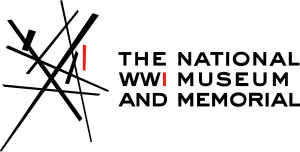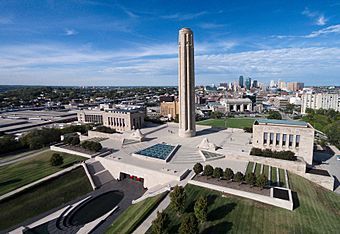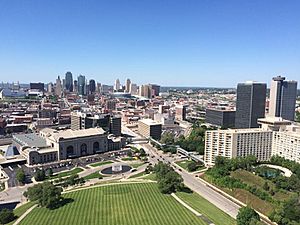National World War I Museum and Memorial facts for kids

Intersections, 2017 logo
|
|
| Established | November 11, 1926 |
|---|---|
| Location | Penn Valley Park, Kansas City, Missouri, U.S. |
| Public transit access | Streetcar, bus |
| Nearest parking | Onsite (no charge) |
|
National World War I Museum and Memorial
|
|

Museum in the Kansas City skyline
|
|
| Built | 1926 |
| Architect | Harold Van Buren Magonigle, Westlake Construction Company George Kessler, landscape architect |
| Architectural style | Beaux Arts Classicism, Egyptian Revival |
| NRHP reference No. | 00001148 |
| Significant dates | |
| Added to NRHP | September 20, 2006 |
| Designated NHL | September 20, 2006 |
The National World War I Museum and Memorial is a special place in Kansas City, Missouri. It first opened in 1926 as the Liberty Memorial. In 2004, the United States Congress officially named it the country's main war memorial and museum for World War I.
A non-profit group works with Kansas City to manage this important site. The museum teaches visitors about global events leading up to World War I. It covers the war itself, which ended in 1918, and the peace talks that followed. Inside, you walk across a glass bridge over 9,000 red poppies. Each poppy represents 1,000 soldiers who died in the war.
The museum closed for updates in 1994. It reopened in December 2006 with more space. This allowed it to show off a larger collection of items from the war, which started being gathered in 1920.
Contents
History of the Memorial
Building the Liberty Memorial
Soon after World War I ended, a group of 40 important people in Kansas City decided to build a memorial. They wanted to honor everyone who served in the war. They formed the Liberty Memorial Association (LMA) for this purpose.
A wealthy businessman named Robert A. Long was chosen as president. He also gave a lot of his own money. Other important people like J. C. Nichols and William Volker helped get the land. A famous landscape designer, George Kessler, planned the outdoor areas. The architect chosen to design the memorial was Harold Van Buren Magonigle.
In 1919, the LMA asked people for donations. Over 83,000 people gave money, raising more than $2.5 million in less than two weeks. This showed how much people wanted to honor the soldiers. This strong support helped avoid money problems that other memorials had faced.
Special Dedication Ceremonies
On November 1, 1921, a huge groundbreaking ceremony took place. About 200,000 people attended. Many important leaders from different countries were there. These included Vice President Calvin Coolidge and generals from Belgium, Great Britain, Italy, France, and the United States.
A local veteran named Harry S. Truman presented flags to these commanders. He later became the 33rd President of the United States. The finished memorial was officially opened on November 11, 1926. President Coolidge spoke at the event, saying the memorial was for "peace and liberty."
Updating the Memorial
In 1935, sculptures of the important generals were added. These were created by Walker Hancock.
In 1961, former President Harry S. Truman rededicated the monument. Local groups helped restore the memorial, which was starting to show its age. A large ceremony with 15,000 people marked its 40th anniversary.
By 1994, the memorial needed major repairs due to drainage issues and aging. It had to close for safety reasons. Local shopping malls even helped display some of the museum's items while it was closed. In 1998, Kansas City voters approved a special sales tax to pay for the restoration.
Plans were made to add a new, larger museum space. With support from around the world, $102 million was raised. The expanded museum reopened in 2006. In 2004, the U.S. Congress named it the nation's official World War I museum. Construction began on a new 80,000 square foot expansion underground. The Liberty Memorial became a National Historic Landmark on September 20, 2006.
Another big renovation started in 2011, costing about $5 million. This included making the building more energy-efficient. The flame effect at the top of the tower was also improved and relit in 2013. Security was updated, and parts of the stone exterior were repaired.
A new area called the Wylie Gallery was planned for 2018. It uses unused space on the east side of the museum. This gallery hosts special exhibits that travel from other places around the world.
Becoming a National Museum
On December 19, 2014, President Barack Obama signed a law. This law officially recognized the entire site as the National World War I Museum and Memorial.
Memorial Design
The design for the memorial was chosen through a national competition. The winning design came from New York architect Harold Van Buren Magonigle.
Liberty Tower

The main entrance has large bronze doors. The walls inside are made of special stone from Minnesota and Italy. At night, the top of the 217-foot-tall tower lights up. Steam and bright red and orange lights create the illusion of a burning flame. This fiery effect can be seen from far away. The entire memorial stands 265 feet above the ground.
Four large sculptures, called the Guardian Spirits, sit on top of the tower. Each one is 40 feet tall and holds a sword. They represent important values: Honor, Courage, Patriotism, and Sacrifice.
Outside Buildings
The tower and other buildings are designed in a classical Egyptian Revival architecture style. They have a limestone exterior. The base is made of granite.
On each side of the main deck are Exhibition Hall and Memory Hall. Memory Hall has murals that were originally painted for a famous building in Paris. They were updated in the 1950s.
Between each hall and the tower, you'll see two stone sphinxes. They are named "Memory" and "Future." They cover their faces with their wings. Memory faces east, as if shielding its eyes from the terrible battlefields of Europe. Future faces west, hiding its eyes from what is yet to come.
Main Museum Building
The museum part is mostly underground. It was designed to expand the original memorial. On the north side, below the Liberty Tower, there is a large artwork on the wall. You can see it from the nearby Union Station.
The Grounds
The outdoor areas were designed by George Kessler. He was famous for planning Kansas City's beautiful park system.
Near the museum entrance, there is a large oval fountain. Staircases on each side lead up to the memorial deck. From the south, you can walk along the Walk of Honor. This path has engraved bricks that remember veterans of World War I, veterans of all wars, and honored civilians.
Museum Features
The museum has many interesting things to see and do:
- Two main galleries filled with real items from the war. The first gallery shows how the war started before the U.S. joined. The second focuses on America's role and efforts for peace.
- You can see a Renault FT tank.
- There are uniforms, like Paul von Hindenburg's jacket.
- A 1917 Harley-Davidson motorcycle is on display.
- You can also see a 1918 Ford Model T ambulance.
- General John J. Pershing's special flag is here.
- There are also weapons, maps, photos, and propaganda posters.
- You can explore replica trenches.
- The museum has modern interactive displays.
- Sound booths let you listen to recordings from that time.
- Two theaters show educational films. One film prepares you for the first gallery, and a larger one is seen before the second gallery.
- The Edward Jones Research Center holds 75,000 historical documents and 9,500 books.
- The R.A. Long Education Center is a room for meetings and classes.
- The J.C. Nichols Auditorium hosts special events.
- The Over There Café has flags, music, and food inspired by the Great War.
- There is also a museum store.
See also





